Task Force Smith Historic Trail - Battle of Osan
Introduction
Text-to-speech Audio
The Battle of Osan is the location of the first American battle in the Korean War. On 5 July 1950 at approximately 0816 the first American artillery was fired at approaching North Korean tanks. The American combat unit led by Lieutenant Colonel Charles B. Smith, consisted of "540 Americans: 389 enlisted men and 17 officers among the infantry and 125 enlisted men and 9 officers among the artillerymen"[1] and is known as Task Force Smith.
The Republic of Korea honors the bravery of Task Force Smith with a memorial ceremony every 5th of July. The UN FORCES First Battle Memorial and Task Force Smith Museum was constructed at the site of the location of the battle to honor the sacrifices of Task Force Smith and the alliances that were born from the Korean War.
The Task Force Smith Historic Trail traces the journey of Task Force Smith from Pyeongtaek Station to the Battle of Osan. This trail is designed for hiking, biking, and walking. It is 20 miles long (32 km). The trail is connected to various train stations and passes through historical locations such as the Battle of Osan.
Images
Road Leading to Suwon is visible for eight miles from the Task Force Smith position near Osan
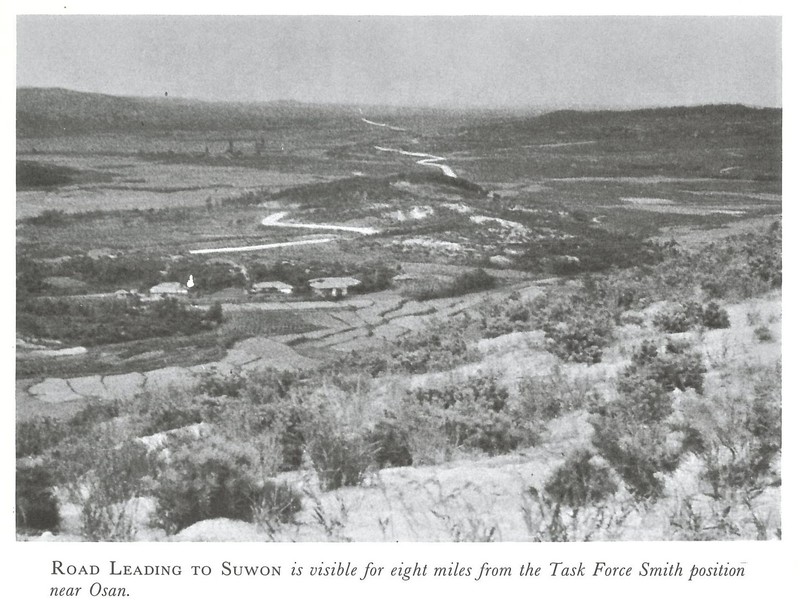
Task Force Smith at Osan
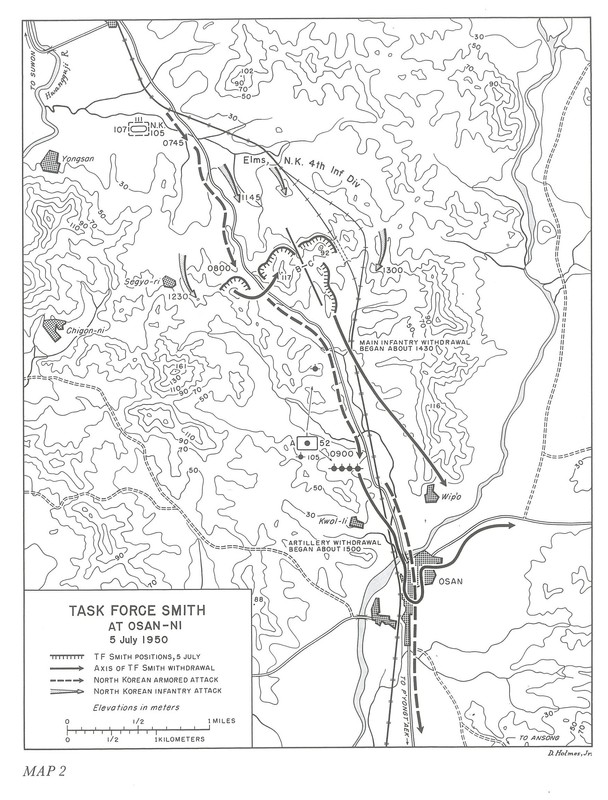
Task Force Smith Memorial Ceremony 5 July 2022
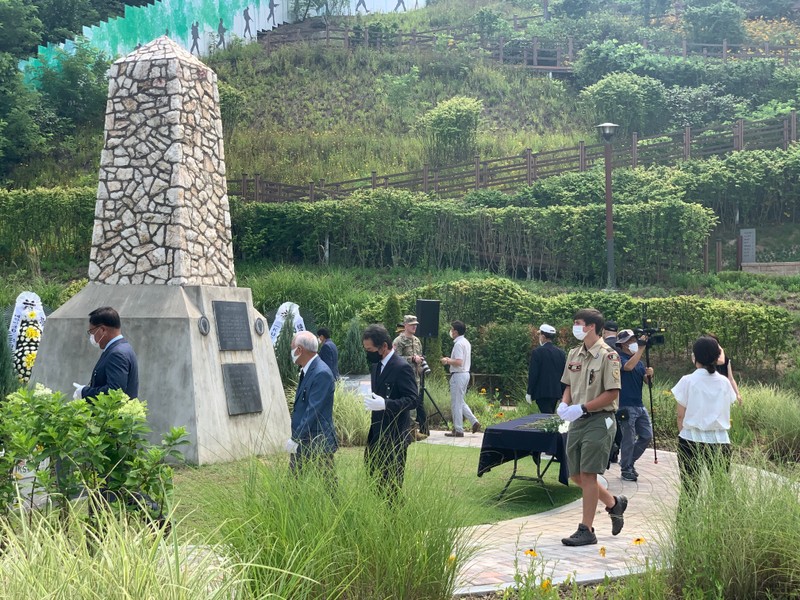
Members of Task Force Smith, in action against North Korean forces. At right is Private First Class Kenneth Shadrick from West Virginia, who was killed by enemy fire a few moments after this photo was made, thus becoming the first United States soldier to die in the Korean campaign.
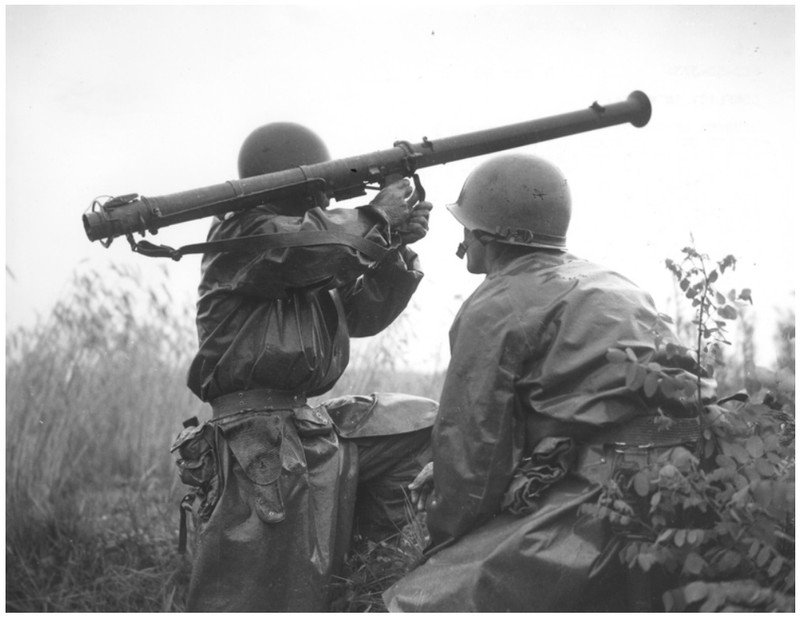
Task Force Smith Historic Trail Map
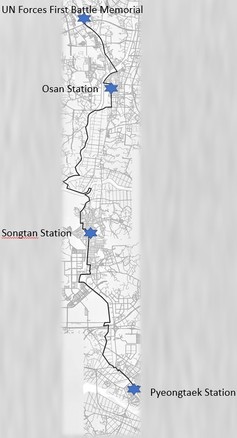
Backstory and Context
Text-to-speech Audio
On 2 July 1950, after arriving in Taejon by train from Pusan, Lieutenant Colonel Smith decided to rest his men and with a small command group headed north to conduct a reconnaissance of defensive positions. "Thus it was that he found himself finally on top of the scrubby hill, about three miles north of Osan" and "from his vantage point, about 300 feet above the valley floor, Smith saw a road and railroad heading off to the northwest. The hill on which he stood extended to his left and right, forming a low ridge perpendicular to the road. About a mile and quarter to his front, the railroad parted from the road and swung around the east end of the ridge...Smith could see almost all the way to Suwon, eight miles to the north. This, he decided would be his initial defensive position."[2]
After returning to Taejon that night, Smith was ordered to take his men north to Pyeongtaek and Ansong. Arriving on 3 July with a company in each town they awaited further orders.
On 4 July, Smith's divided command reunited at Pyeongtaek and was joined by a part of the 52nd Field Artillery Battalion led by Lieutenant Colonel Miller O. Perry that had crossed from Japan on 2 July and made their way north by train.
A little after midnight on 5 July Task Force Smith moved out of Pyeongtaek to take up their positions near Osan. Around 0300 Task Force Smith reached the position that Smith had selected.
"On his left flank Colonel Smith placed one platoon of B Company on the high knob immediately west of the highway; east of the the road were B company's other two rifle platoons. Beyond them eastward to the railroad tracks were two platoons of C company. This company's third platoon occupied a finger ridge running south, forming a refused right flank along the west side of the railroad track. Just east of the highway B Company emplaced the other 75-mm recoilless rifle just west of the railroad. Colonel Smith placed the 4.2-inch mortars on the reverse, or south, slope of the ridge about 400 yards behind the center of B Company's position."[3]
The artillery was located two thousand yards behind the infantry with four 105-mm howitzers. There were 1200 rounds of High Explosive artillery ammunition with about 6 rounds of High Explosive Anti-tank (HEAT) rounds.
On the morning of 5 July it was raining and around 0700 Smith saw a column of tanks (Russian-built T34's) moving toward their position. The artillery fired on the tanks but was ineffective. Smith ordered that when the tanks were within 700 yards of the infantry for the recoilless rifles to fire. They were direct hits but did not impact damage to the tanks. The infantry fired 2.36-inch rocket launchers but were also ineffective. As the tanks crested the road the 105-mm howitzers from the artillery position fired High Explosive Anti-tank (HEAT) rounds. Two of the lead tanks were damaged and pulled off the road but the HEAT rounds were quickly spent and the High Explosive (HE) rounds were ineffective.
Following the first round of tanks, further North Korean tank groups came through the low ground between Task Force Smith's defensive positions. In the first hour of battle, T-34 tanks had claimed the lives of 20 men from Task Force Smith. Lieutenant Colonel Perry and his men in the artillery position fought bravely with Perry leading bazooka teams. Perry was wounded in the leg from small arms fire.
After the last of the tank columns had passed through the infantry position an hour had passed and Smith saw a column of infantry and trucks about six miles long. "There could be no doubt about it, this was a major force of the North Korean Army pushing south - the 16th and 18th Regiments of the North Korean Division, as learned later."[4]
As the North Korean infantry convoy approached, Smith "through the book at them. Mortar shells landed among the the trucks and .50 caliber machine gun bullets swept the column. Trucks burst into flames."[5] The enemy infantry moved up the hill but did not attempt to outflank the Task Force Smith position. At about 1430 Colonel Smith decided the time to move out this defensive position was necessary. Smith planned to withdrawal by staggering his men with each group providing cover to the next. The selected route of withdrawal was toward Osan down the finger ridge on the right flank.
After the initial covering unit was ready to withdrawal Smith left the hill followed the railroad tracks through the rice paddies to locate Perry to tell him the infantry was withdrawing.
Task Force Smith was outnumbered by North Korean soldiers and tanks, they fought bravely for hours until finally withdrawing back south where many regrouped with the 24th infantry division.
Sources
[1] Appleman, Roy E. U.S. Army in the Korean War. South to the Naktong, North to the Yalu (June-November 1950), Washington, D.C.. Center of Military History, United States Army, 1986.
[2] Flint, Roy K.. Charles, Heller E.. America's First Battles, 1776-1965 - Task Force Smith and the 24th Division. University Press of Kansas.
[3] Appleman, Roy E. U.S. Army in the Korean War. South to the Naktong, North to the Yalu (June-November 1950), Washington, D.C.. Center of Military History, United States Army, 1986.
[4] Appleman, Roy E. U.S. Army in the Korean War. South to the Naktong, North to the Yalu (June-November 1950), Washington, D.C.. Center of Military History, United States Army, 1986.
[5]Appleman, Roy E. U.S. Army in the Korean War. South to the Naktong, North to the Yalu (June-November 1950), Washington, D.C.. Center of Military History, United States Army, 1986.
Appleman, Roy E. US Army in the Korea War, South to the Naktong, North to the Yalu
Appleman, Roy E. US Army in the Korea War, South to the Naktong, North to the Yalu
Carson, Beau
https://www.trumanlibrary.gov/photograph-records/2007-433
Carson, Beau
